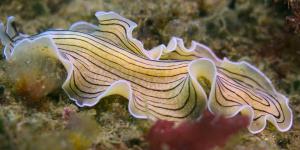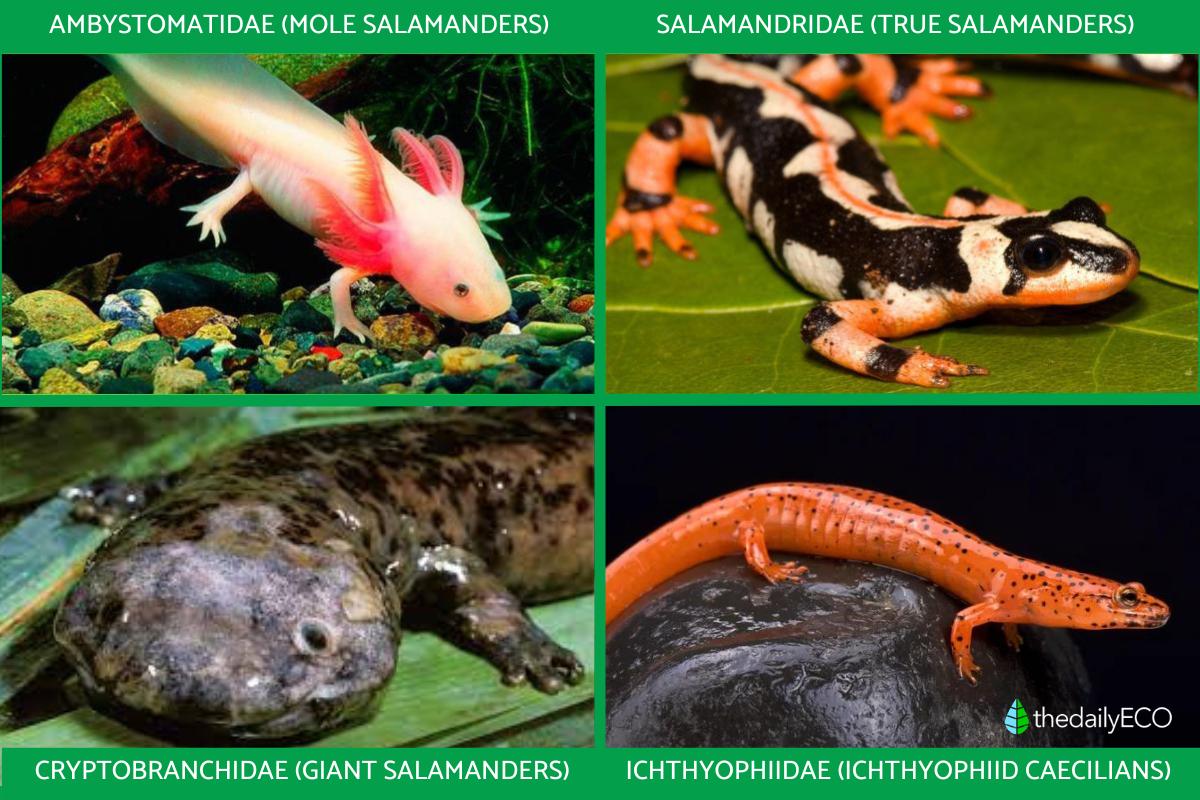What Are Amphibians? - Definition, Types and Examples


Amphibians are a remarkable class of vertebrate animals that occupy a unique ecological niche in the animal kingdom. Their name, "amphibian," hints at their dual life, as these fascinating creatures often bridge the gap between aquatic and terrestrial habitats. With a lineage dating back hundreds of millions of years, amphibians have honed a remarkable array of adaptations that allow them to thrive in environments as diverse as tropical rainforests, arid deserts, and freshwater ecosystems.
The following article by thedailyECO provides insights into the definition of amphibians, their classification, and their key distinguishing features.
What are amphibians?
Amphibians are a diverse group of vertebrate animals that belong to the class Amphibia. They are characterized by several key features that set them apart in the animal kingdom. Here are some defining characteristics of amphibians:
- Permeable skin: amphibians are known for their permeable skin, which has both advantages and challenges. While it enables efficient gas exchange, it also makes them susceptible to drying out. Therefore, amphibians rely heavily on water to keep their skin moist.
- Solitary habits: amphibians typically lead solitary lives, except during the mating season, when they come together in aquatic environments to lay their eggs. This gregarious behavior is crucial for their reproduction.
- Ectothermic nature: unlike mammals and birds, amphibians are ectothermic, meaning they can't regulate their body temperature internally. They rely on external heat sources, like the sun or warm surfaces, to maintain their metabolism. This makes them sensitive to temperature changes.
- Metamorphosis: amphibians undergo a fascinating transformation in their life cycle. They start as aquatic larvae with gills for breathing and later become adults with lungs for terrestrial respiration. The presence or absence of limbs in adult amphibians varies among species.
- Dietary adaptations: amphibians have diverse diets throughout their life stages. Larvae often consume plant matter, plankton, or algae, while adult amphibians are primarily carnivorous, preying on insects and other invertebrates. This helps control insect populations in their ecosystems.
- Dual respiration: amphibians are capable of both cutaneous respiration (breathing through their skin) and pulmonary respiration (breathing with lungs). Larval amphibians mainly rely on gills for respiration, while adult amphibians use their lungs, skin, and sometimes buccal respiration (exchange of gases through the mouth lining).
- Limbs: most amphibians have limbs with webbed toes, but there is variation among species. Some have fully developed legs, while others may have reduced or absent limbs, depending on their order and adaptations to their specific habitat.
Amphibians include well-known groups such as frogs, toads, salamanders, and newts. They play essential roles in ecosystems as both predators and prey, and they are often considered bioindicators of environmental health because they are sensitive to changes in habitat quality.
Classification of amphibians
Amphibians, belonging to the phylum Chordata and the class Amphibia, are divided into three families. Among them, Lissamphibia is the only family that comprises living species, while the other two families, Lepospondyli and Temnospondyli, are no longer extant.
Now, let's explore the orders within the Lissamphibia family:
- Anura: this order includes frogs, toads, and similar species. Anurans are characterized by their jumping ability, webbed feet, and lack of tails in adults. They are found worldwide and are known for their diverse adaptations to various environments.
- Gymnophiona: gymnophionans, or caecilians, are legless amphibians with a snake-like appearance. They are primarily found in tropical regions, especially in South America, Africa, and Southeast Asia. Caecilians are burrowers and spend much of their lives underground. They are known for their specialized adaptations for a fossorial (burrowing) lifestyle.
- Caudata: this order includes salamanders and newts. Salamanders are known for their long bodies, long tails, and moist skin. They have a diverse range of species, some of which are fully aquatic, while others are terrestrial. The axolotl, a Mexican neotenic salamander, is a well-known example.
Each of these orders has its own unique set of characteristics and adaptations that make them intriguing members of the amphibian class.
Anurans
Anurans, encompassing frogs, toads, and similar species, are distinguished by several notable characteristics. These fascinating amphibians are renowned for their distinctive features and behaviors:
- Anurans are equipped with muscular hind legs that are folded close to their bodies, poised for powerful leaps. This adaptation enables them to make remarkable jumps, making them exceptional jumpers among amphibians.
- They possess large, bulging eyes and a sizable mouth. These adaptations aid in their vision and feeding behaviors, allowing them to spot prey and capture it efficiently.
- Anurans are the only order of amphibians that lack a tail in adulthood. Their tails typically disappear during the transition from the larval phase to the adult phase, resulting in their characteristic tailless appearance.
- Anurans predominantly feed on insects, although some species may consume small mammals and other anurans. Their hunting technique involves stalking their prey and executing precise jumps to capture it.
- Males of many anuran species produce distinctive croaking calls as part of their courtship rituals to attract females. Each species has its unique call, contributing to species-specific communication.
- Anurans engage in external reproduction. The female lays her eggs, typically in water, and the male fertilizes them by releasing sperm. During this process, known as amplexus, the male clasps the female from above to facilitate fertilization.
There are over 50 families of Anura, each containing numerous species with distinct characteristics and adaptations. Here are a few more examples:
- Ranidae (True Frogs): true frogs are a diverse family of Anura, with over 800 species. They typically have smooth skin and are known for their webbed feet. Examples include the common green frog (Rana clamitans) and the bullfrog (Lithobates catesbeianus).
- Hylidae (Tree Frogs): tree frogs are known for their adhesive toe pads, which allow them to climb and adhere to various surfaces. They often have vibrant colors and are commonly found in trees and shrubs. Examples include the red-eyed tree frog (Agalychnis callidryas) and the gray tree frog (Hyla versicolor).
- Microhylidae (Narrow-mouthed Frogs): these frogs are characterized by their small size and narrow mouths. They often have a secretive lifestyle and are found in various habitats, including terrestrial, arboreal, and aquatic. Examples include the painted burrowing frog (Chiasmocleis ventrimaculata) and the eastern narrow-mouthed toad (Gastrophryne carolinensis).
- Rhacophoridae (Flying Frogs): flying frogs have adaptations for gliding or parachuting, such as webbed toes and large webbed hands and feet. They are primarily found in tropical regions of Asia. Examples include the Wallace's flying frog (Rhacophorus nigropalmatus) and the Malabar gliding frog (Rhacophorus malabaricus).
- Pipidae (African Clawed Frogs and Surinam Toad): this family includes aquatic frogs with unique characteristics. The African clawed frogs (Xenopus) have claw-like toes and are often used in scientific research. The Surinam toad (Pipa pipa) has a flattened body and gives birth to live young, which develop in pockets on its back.
Be sure to read this other article that explores what the difference between frogs and toads is.

Gymnophiones
Gymnophiones, also known as Caecilians, are a group of amphibians that distinguish themselves through several distinctive characteristics and behaviors:
- Caecilians, unlike frogs and toads, have evolved into limbless creatures with elongated bodies. This adaptation allows them to move effectively through soil and burrow into their environments.
Unlike snakes, their tails do not taper towards the end; instead, their tails maintain a consistent width. - Caecilians possess tiny, often nearly non-existent eyes, as they primarily rely on other senses, such as touch and smell, to navigate their surroundings.
- Their skin exhibits folds and segments that somewhat resemble those found in annelid worms, aiding their burrowing abilities.
- Caecilians display a broad size range, spanning from small individuals measuring around 12 centimeters to much larger specimens reaching up to one and a half meters in length, depending on the species.
- Caecilians exhibit diverse lifestyles. Some are burrowers, dwelling in subterranean environments, where they rely heavily on their acute sense of smell for navigation. They feature retractable tentacles, which assist in chemical sensing. Others are entirely aquatic, and some possess fins for swimming.
- Caecilians employ a range of reproductive strategies. Some species practice internal fertilization, with females giving birth to either live larvae or fully developed adults. Others may lay eggs that develop externally.
There are approximately 11 recognized families within the order Gymnophiona:
- Caeciliidae (Caecilians): is a diverse family of caecilians found in tropical regions worldwide. Within this family, you can find various genera and species, each with distinct features and behaviors. Caecilians in this family may exhibit adaptations for burrowing or aquatic lifestyles.
- Ichthyophiidae (Ichthyophiid Caecilians): includes caecilians primarily found in Asia. They are known for their intriguing parental behaviors, such as guarding their eggs and young. This family showcases a range of species with various ecological roles.
- Rhinatrematidae (South American Caecilians): represents caecilians found in South America. While smaller in terms of species diversity compared to other families, it still encompasses several unique caecilian species adapted to South American ecosystems.
- Scolecomorphidae (Scolecomorphid Caecilians): is a family of caecilians found in Central and South America. These caecilians typically have elongated bodies and adapt to burrowing lifestyles in the humid forests of their range.
- Typhlonectidae (Aquatic Caecilians): encompasses aquatic caecilians commonly found in South America. They are well adapted to aquatic habitats and are known for their streamlined bodies and fin-like tails, which enable them to move efficiently in water.
- Herpelidae (African Caecilians): is a family of caecilians primarily found in the sub-Saharan regions of Africa. These unique amphibians have evolved to thrive in a variety of terrestrial and aquatic environments.
- Dermophiidae (Burrowing Caecilians): is a distinctive family of caecilians renowned for their specialized adaptations to a subterranean lifestyle. These caecilians are predominantly found in regions of Central and South America.
Caecilians are known for their unique respiratory adaptations. While they do have rudimentary lungs, they primarily respire through their skin. Learn more about what cutaneous respiration is in this other article.

Caudates
Caudata, comprising salamanders and newts, also stands out as a remarkable group of amphibians, showcasing a range of distinctive traits and behaviors:
- Caudates possess moist, permeable skin, a common feature among amphibians. This skin allows for efficient gas exchange, enabling them to respire through their skin and adapt to various aquatic and terrestrial environments.
- Many Caudata species undergo metamorphosis, transitioning from an aquatic larval stage to an adult stage, which can be terrestrial or aquatic. During this transformation, they often develop lungs for breathing air, although they may retain some aquatic characteristics.
- Unlike caecilians, salamanders and newts typically have limbs, though some species may exhibit limb reduction or loss. These limbs are adapted for various modes of locomotion, such as walking, climbing, and swimming.
- Caudates typically retain their tails throughout their lives, and the tail plays a role in balance, swimming, and, in some species, courtship displays.
- Most Caudata are carnivorous, preying on insects, small invertebrates, and other prey. They are skilled hunters and use their projectile tongues to capture fast-moving prey.
- Some species of Caudata employ vocalizations and chemical signals as part of their communication and courtship behaviors, although this varies among species.
- Many species of salamanders possess skin glands that secrete toxins or chemicals, serving as a defense mechanism against predators. These skin secretions can vary in potency.
The order Caudata, which includes salamanders and newts, is typically divided into ten families. Here are some notable families within the order Caudata:
- Salamandridae (True Salamanders and Newts): is a diverse family of salamanders and newts found primarily in Europe, Asia, and North America. These amphibians are known for their vibrant colors, often displaying bright patterns and distinct markings. Some well-known members of this family include the red-spotted newt (Notophthalmus viridescens) and the fire salamander (Salamandra salamandra).
- Plethodontidae (Lungless Salamanders): is a large family of salamanders primarily found in the Americas. These lungless salamanders breathe through their skin and the lining of their mouth, enabling them to occupy a wide range of terrestrial and arboreal habitats. Examples include the red-backed salamander (Plethodon cinereus) and the arboreal salamanders (Aneides spp.).
- Ambystomatidae (Mole Salamanders): includes a variety of mole salamanders found in North America. These salamanders are often characterized by their stout bodies and terrestrial lifestyles. The spotted salamander (Ambystoma maculatum) and the marbled salamander (Ambystoma opacum) are among the well-known members of this family.
- Cryptobranchidae (Giant Salamanders): consists of the giant salamanders, which are primarily found in East Asia and North America. These amphibians are known for their large size and aquatic habits. The Japanese giant salamander (Andrias japonicus) and the eastern hellbender (Cryptobranchus alleganiensis) are notable members of this family.
- Proteidae (Mudpuppies and Waterdogs): includes aquatic salamanders found in North America. They are often characterized by their external gills, which they retain throughout their lives. Mudpuppies (Necturus spp.) and waterdogs (Necturus maculosus) are examples within this family.
Be sure to read this other article that explains the differences between salamander and geckos.

If you want to read similar articles to What Are Amphibians? - Definition, Types and Examples, we recommend you visit our Wild animals category.
- Beatty, R., Beer, A., & Deeming, C. (2010). The Book of Nature. Great Britain: Dorling Kindersley.








